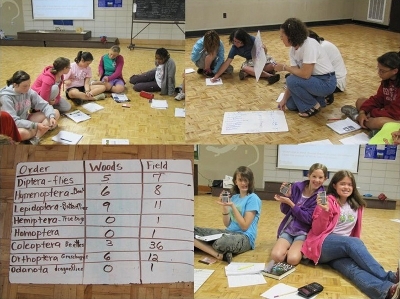
NIMBioS Education Module
Quantifying Biodiversity
This module was developed for grades 6-8, but may be adapted to older grades. Almost everyone has heard about how important biodiversity is. Biodiversity makes ecosystems more productive, and it allows us a greater opportunity to find new organisms that will make important food or medicines for us. Or you may have heard that a place like the Great Smoky Mountains National Park is a "biodiversity hotspot" and should therefore be preserved. But what exactly is biodiversity? And how does one say that biodiversity is greater in one place than another?
In this module, students will learn the ecologists' definition of biodiversity, and also two different ways that an area's tally of organisms can differ: species richness and species evenness. Then, using a hypothetical example of insect data from a forest and a field, they will create a hypothesis of which area will have the greatest biodiversity. Then, they will learn about and use Simpson's Index of Biodiversity, a real-world application of probability, to test out their hypothesis.
It is recommended that this module serve as an introduction to the topic, after which the concepts can be applied to real data gathered by students. For example, students could count insects from two different areas in the schoolyard or could inventory tree species found in their yards at home or in a local park.
Presentation and Worksheet Files:
Biodiversity Module Part I
(.pptx)
(.pdf)
Biodiversity Module Part II
(.ppt)
Biodiversity Worksheet:
(.pdf)
(.docx)
Biodiversity Data Set
(.xlsx)
Materials Needed: Worksheet, calculator, pencil
More Versions of This Activity:
A version of this activity appropriate for high school was published in the Mathematics Teacher in 2014:
Duncan SI, Lenhart S, Sturner KK. 2014. Activities for students: Measuring Biodiversity with probability. Mathematics Teacher 107(7):547-552. [Online]
[PDF]
Another version of this activity, adapted for 4H coordinators, is available here: Biodiversity Counts!
Quantifying Biodiversity Module in action:
Girls in Science Campers Quantify Smokies Stream Biodiversity
Girls in Science Campers Do the Data Crunch
NIMBioS Puts the M in Girls Scouts' STEM Day
High School Scholars Connect Math and Biology Using Biodiversity
Other NIMBioS education modules
For further information, please contact:
|
Suzanne Lenhart Associate Director for Education and Outreach Email: slenhart@tennessee.edu Ph: (865) 974-4270 (Math) (865) 974-9349 (NIMBioS) Fax: (865) 974-9300 | |
|
NIMBioS, 1122 Volunteer Blvd., Suite 106 University of Tennessee Knoxville, TN 37996-3410 | |
NIMBioS
1122 Volunteer Blvd., Suite 106
University of Tennessee
Knoxville,
TN 37996-3410
PH: (865) 974-9334
FAX: (865) 974-9461
Contact NIMBioS


